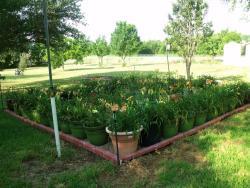CaliFlowers said:
Another trick I've used is to cut water bottles to make 3" tall "cups" and set them in the bottom of containers with normal drainage holes.
--This is a great idea, Ken! I tend to have all kinds of plastic containers circulate through here that I can start cutting off - milk, coffee, orange juice - seems like a lot of things are in plastic containers that would work. Definitely something I can and will try.
It's hard to find real soap anymore, and the detergents in most cleansers are probably harmful to the soil, plants and soil organisms.
--I have some Murphy's that I've used to mix with water to spray plants. I wonder if that will work? It doesn't damage the plants if they are sprayed, so I wouldn't think it would hurt with a soil application. I'm just not exactly clear on how it's supposed to work by putting it on the soil. Maybe it would be more efficient to mix some in water to start out with and then water the container as usual afterwards.
The alcohol-based surfactants are the most powerful, but are probably not that good for soil health, so I use CoCo-Wet and other horticultural wetting agents, one of which was a Yucca-based wetting agent that I can't remember the name of. They work fine, but I've heard that regular use of any wetting agent isn't recommended–the person said something about soil structure and water-uptake chemistry. Seems to me that daylilies get so much water run through them that a dose of wetting agent once a month shouldn't hurt anything.
--Wetting agents always seem a bit high priced to me.
I think the soil "shrinks" initially because of root contraction, and once a channel for water appears, soil can escape from the pot, the rootball dries more, and a viscious cycle begins.
--Yep.
Capping the soil mix with a thin layer of garden soil has worked very well for me, because mineral-based soil re-wets easily, resists channeling, and promotes slow, even percolation. It also works its way into the potting mix slowly, which seems to help all aspects of plant growth.
-With my red clay, that might be more like capping it with concrete. Once it gets really dry, it repels water for a while. Using my yard soil has always led to trouble sooner or later. Usually sooner :(.
In extreme cases of dry rootball, I have to dunk the pot in a big bucket of water for a couple of hours to soak it all the way through. That's when the wetting agent really comes in handy. A good rinse-through afterward, and some liquid fertilizer, and they're good-to-go again.
--Dunking and setting containers in water is my 'go to' method on pots I can manage to lift. I even got a couple of cheap child swimming pools that have big pots sitting in them. The problem with those big pots is lifting them. When they are dry I could probably get them in, but once the soil is thoroughly wet I'd probably have to get help to lift them back. Manageable when I was younger maybe, but asking for trouble to try it now. I've still considered setting one or two in those kiddie pools, though, and then waiting 'til someone drops by that I can get to help me lift them out :).
Recently, I've had good luck using a bark-heavy mix. It seems to stay broken up better than bagged peat-based potting soils. Fine orchid bark, with particles around 3/16 - 1/4 works the best.
--I use bark in my mixes. Too expensive to only use potting mix for pots that large. That's why I put limbs, twigs, leaves and other organic material hugelkultur style to take up space. The plants don't object, but it didn't last through the season. I guess the organics just broke down too quickly and now I'm needing to replenish the volume. The daylilies do a good job filling even large containers with roots. For some reason clay pots don't have as much shrinkage as the plastic. I wonder if the clay, soil and roots tend to bond a bit where the plastic doesn't bond at all.
A good starting point is 5 parts bark, 1-2 parts potting mix, 1part perlite, plus some dolomitic lime. There's a lot of info about this mix online, search "5-1-1", "container" and "soil".
--Daylilies haven't proved to be all that picky about the mix. At least mine haven't. Mostly they grow well and I do try to give a bit of supplemental fertilizer from time to time to compensate for what gets used up and leeches out.



sooby said:Basically what happens is that water does not want to cross the junction between finer material and coarse material, so the flow of water comes to a stop when it gets to the coarse material. It won't cross that boundary until it is basically "forced" to do so when the top fine material becomes so saturated that it can't hold any more water.
This phenomenon is called a "perched water table". It's the principle used to build sand-based golf greens and was discovered over a hundred years ago but still we see coarse material recommended at the base of pots.
touchofsky said:If you want to make a large terracotta planter lighter, what would you suggest?
I have been putting broken bits of styrofoam in the bottom, but maybe this isn't a good idea.